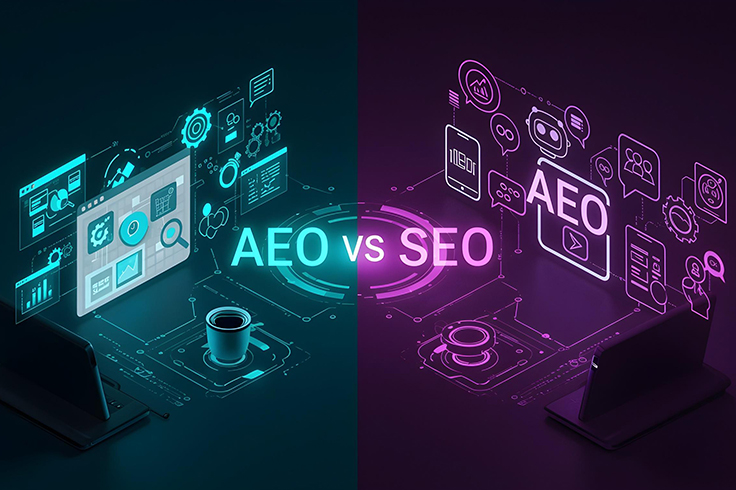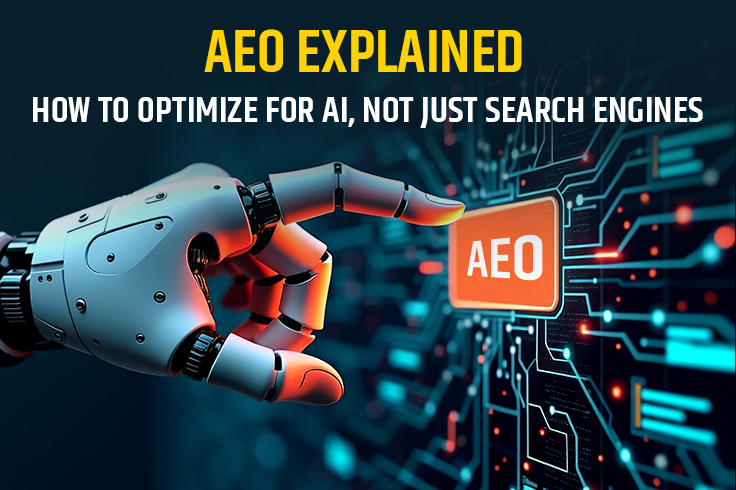Why AEO Is the Future of Online Visibility
If you’re still optimizing solely for Google’s 10 blue links, you’re already behind. Welcome to 2025—the year where Answer Engine Optimization (AEO) takes center stage. AEO is not just a buzzword. It’s a total shift in how content is discovered and consumed online. With the rise of AI-powered tools like ChatGPT, Google SGE (Search Generative Experience), Bing Copilot, and Alexa, people are no longer just “searching”—they’re asking. And they want answers, not options.
So, what exactly is AEO? In short, it’s the art of structuring content so AI can understand it, extract the right answers, and deliver them to users immediately. Unlike traditional SEO, which focuses on rankings, AEO is all about relevance and precision. The goal isn’t just to be seen—it’s to be the best, most trusted answer.
Recent studies show that over 60% of all searches result in zero clicks, thanks to AI-generated snippets, featured answers, and voice responses. That means your beautifully optimized blog might never get clicked—unless it’s optimized to be the answer.
AEO vs SEO: What’s the Real Difference?

Let’s not sugarcoat it: SEO and AEO are not the same. While they share some tactics, their goals, audiences, and formats are fundamentally different.
| Feature | Traditional SEO | AEO (Answer Engine Optimization) |
| Goal | Drive clicks to website | Provide direct, AI-friendly answers |
| Format | Long-form, keyword-rich | Concise, structured, answer-based |
| Tools | Meta tags, backlinks | Structured data, schema, NLP formatting |
| Audience | Search engines, users | AI engines, voice assistants, SGE |
| Engagement | Page views & dwell time | Direct answers & mentions |
Think of SEO as trying to get someone to walk into your store. AEO is when someone asks a friend what to buy and your brand is what they recommend. In this analogy, AI is the friend—and your content needs to be the one it trusts enough to mention.
SEO is still useful. You’ll always want to appear in organic results. But if you want to own the AI answer box, you need to format your content differently. That’s where AEO comes in.
How AI Has Changed the Way People Search

Let’s talk behavior. AI isn’t just transforming tech—it’s transforming how humans ask for information. Instead of typing “best iPhone in 2025,” users are now asking, “Which iPhone model should I buy for professional photography?”
AI tools, unlike search engines, don’t just match words—they interpret intent. They consider context, sentiment, and nuance. They understand whether someone wants a product recommendation, a tutorial, or a quick stat. This is possible through Natural Language Processing (NLP), a field that’s evolved rapidly in just the last few years.
And here’s the kicker—AI doesn’t just fetch one answer. It aggregates, analyzes, and prioritizes the most credible, well-structured answers available. If your content isn’t optimized for that kind of analysis, you’re not even in the running.
Voice search is booming, too. With smart speakers in over 300 million households globally, people are now asking their devices everything—from “how to cook quinoa” to “best CRM for startups.” The answers don’t come from the first result on Google—they come from content that’s structured, specific, and machine-readable.
How to Structure Content for AI and AEO

So, how do you actually do AEO? It’s not about ditching SEO entirely, but about adapting your approach. Here are the key principles:
1. Answer Real Questions Clearly
Start by identifying actual user questions. Use tools like AnswerThePublic, Reddit, or Google’s People Also Ask. Then, write content that directly answers those questions within the first 40–60 words.
Example:
Question: What is answer engine optimization?
Answer: Answer Engine Optimization (AEO) is a content strategy that structures information in a way that AI tools can understand and present as direct answers to users’ queries.
That’s the level of clarity AI needs. Follow it up with supporting details, examples, or case studies for deeper value.
2. Use Question-Based Headers
Each header should resemble a question someone would ask in real life. Think:
- “How does AEO impact SEO?”
- “Why is structured data important for AI?”
This helps both humans and machines navigate your content more easily.
3. Implement Structured Data (Schema Markup)
AI systems rely on schema to make sense of your content. Add relevant schema types like:
- FAQ
- HowTo
- Article
- Product
- Review
Using free tools like Google’s Rich Results Test or Schema.org generators can help you integrate these in minutes.
4. Optimize for Voice Search and NLP
Voice queries are often longer and more conversational. Optimize your content to reflect that tone. Avoid robotic keyword stuffing and write as if you’re having a one-on-one conversation.
5. Add TL;DRs and Summary Boxes
Include quick-scan elements like:
- Key takeaways
- Bullet-point summaries
- Mini FAQs at the top (for AI to extract)
Remember, AI scrapers look for short, direct summaries they can serve instantly.
AEO in Action: What Success Looks Like
So, what does success look like in an AEO-driven world?
Imagine your brand gets cited in ChatGPT’s response to a product query. Or your local business becomes the top answer when someone asks Siri, “Where’s the best vegan cafe near me?” That’s not random—it’s AEO at work.
Major brands are already ahead. For instance, companies using structured FAQ content with proper schema saw up to 35% increase in AI-referred traffic in 2024 alone, according to Moz.
Small businesses aren’t left out, either. Local shops optimizing for AI-driven local SEO (more on this in our upcoming post: Why AI-Driven Local SEO Is a Game-Changer for Businesses in 2025) are seeing real ROI—especially in voice searches and mobile queries.
Why AEO Matters More Than Ever in 2025 and Beyond
We’re not moving into an AI-first world. We’re already in one. From ChatGPT’s integration with Bing and Siri, to Google’s AI Overview becoming the default view for millions of users, the way people find and consume content is evolving rapidly.
Traditional search results are getting compressed. Rich results, instant answers, voice responses, and chatbot summaries are expanding. If you don’t optimize for those channels, you lose visibility—even if you still rank #1 on Google.
AEO ensures your content is present, accessible, and valuable in every AI-driven interaction. It’s your ticket to owning zero-click traffic, voice search results, and conversational interfaces.
Final Thoughts: Stop Ranking—Start Answering
The future of content isn’t about ranking higher. It’s about answering better.
Whether you’re a SaaS brand, eCommerce store, blogger, or local business—AEO gives you a real edge in the AI-powered world. It’s not a replacement for SEO. It’s the evolution of it. Focus on clarity, structure, relevance, and voice. Create content that’s not just seen—but understood and trusted by AI.

